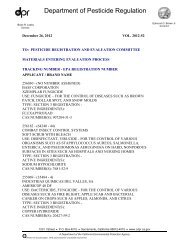Dichlorvos (DDVP) Risk Characterization Document - California ...
Dichlorvos (DDVP) Risk Characterization Document - California ...
Dichlorvos (DDVP) Risk Characterization Document - California ...
You also want an ePaper? Increase the reach of your titles
YUMPU automatically turns print PDFs into web optimized ePapers that Google loves.
B. ACUTE TOXICITY<br />
Summary: The acute toxicities of technical grade <strong>DDVP</strong>, selected formulations, and metabolites are<br />
presented in Tables 1 and 2. The LD 50 of <strong>DDVP</strong> was at least 9 times more toxic than its metabolites<br />
(LD 50 of 250 mg/kg for dichloracetic acid) as determined by the magnitude of the 72 hour lethal dose<br />
after intraperitoneal administration. Human exposure of <strong>DDVP</strong> by ingestion and from the use of nopest<br />
strips resulted in the inhibition of plasma ChE activity, but not erythrocyte ChE activity. Acute<br />
effects observed in laboratory animals from oral or inhalation exposures included diarrhea, irritability,<br />
salivation, lethargy, pupillary constriction, tremors, decreased neuromuscular functions, and death.<br />
TECHNICAL<br />
Gavage - Rat<br />
In a range finding study, rats (Sprague-Dawley Crl:CD.BR, 1/sex/group) were exposed to a single<br />
dose of <strong>DDVP</strong> (97.87% purity; 0, 0.1, 0.5, 1, 10, 20, 30, 40, 60, 70, or 80 mg/kg) in water by gavage<br />
and observed for 24 hours (Lamb, 1992). No clinical effects were observed at 0.1 and 0.5 mg/kg.<br />
There was a dose-related increase in the number and severity of the cholinergic effects at 1 mg/kg<br />
and higher concentrations. Gait alterations (rocking, lurching, swaying, and prostration) and pupil<br />
constriction were observed in the 1, 10, and 20 mg/kg groups. Tremors and reduced<br />
forelimb/hindlimb grasp were additional effects found in the 30 mg/kg group. At 40 mg/kg and higher<br />
concentrations, rats were also severely affected with labored respiration and salivation. One male rat<br />
of the 80 mg/kg group died.<br />
Based on the results of the range finding study, the full study on neurotoxicity was conducted in rats<br />
(Sprague-Dawley Crl:CD.BR, 12/sex/group) with <strong>DDVP</strong> (97.87% purity) at 0.5, 35, and 70 mg/kg<br />
given by a single gavage dose (Lamb, 1993a). At 35 and 70 mg/kg, the effects observed in both<br />
groups (except when noted) included altered posture, clonic convulsions, whole body tremors,<br />
constricted pupils (males only), salivation, increased eye prominence, decreased muscle tone, altered<br />
respiration, pale skin, poor grooming, increased mean time to first step, impaired mobility and gait,<br />
decreased arousal, decreased rearing, absence of approach response (except for 35 mg/kg females),<br />
absence of touch response, absence of tail pinch response, lack of response to olfactory stimuli (70<br />
mg/kg only), absence of pupil response, impaired air righting reflex, reduced hindlimb resistance,<br />
reduced grip strength (70 mg/kg), impaired rotarod performance, increased hindlimb foot splay (70<br />
mg/kg only), increased duration of catalepsy, decrease in body temperature, and reduced motor<br />
activity. Recovery of functional observational battery parameters and locomotor activity was evident<br />
by day 7 for all animals. Six rats of the 70 mg/kg group died. Consistent with the observations in the<br />
range finding study, the NOEL was 0.5 mg/kg based on treatment-related cholinergic signs at 35 and<br />
70 mg/kg.<br />
Intraperitoneal - Rat<br />
Adult male Long Evans rats (12-28/group) were exposed to a single dose of <strong>DDVP</strong> (96% purity) at 0,<br />
5, 10, or 30 mg/kg by intraperitoneal injection for the determination of delayed neuropathy using a<br />
functional observational battery (Ehrich et al., 1993). Atropine was given before treatment, 1 hour<br />
after treatment to those with cholinergic signs, and 2-3 hours after treatment to all animals. At 4 hours<br />
after treatment, four rats from each group were sacrificed in order to determine brain and spinal cord<br />
acetylcholinesterase and neurotoxic esterase activities. Spinal cord ChE as well as brain and spinal<br />
cord neurotoxic esterase activities were significantly (p @ 0.05) reduced by A 30% in a dose-related<br />
manner for all doses. Brain ChE activity was significantly (p @ 0.05) depressed by A 20% only in the<br />
10 and 30 mg/kg groups. There was no treatment-related effect on the body weights. Functional<br />
observational battery showed alterations in the response to approach and activity after 7 to 21 days of<br />
16
















